Text
Taoism, Dumplings, and the Winter Solstice

With each passing day, the sun seems to set earlier and earlier. Just yesterday, I sat down to study a bit for an upcoming test; the sun high above the trees. When I finally decided to take a break, I took a look outside my window only to be met with complete darkness. As winter approaches and we set our clocks back, the darkest day of the year creeps closer. Many people in America, myself included, look over the Winter Solstice but for places like China, it is a cause for celebration, veneration, and good food.
This year, the Winter Solstice falls on December 21st. China's decision to celebrate during the darkest days of the year is not because they love the lack of sun. They celebrate because they know that the sun will only continue to stay out longer after this day and the worst of winter is slowly passing.
However, there's another reason the Winter Solstice is important in Chinese culture; Taoism. Night and darkness, in Taoist tradition, is seen as feminine energy, or Yin. On the flip side, daylight and warmness represents masculine energy or Yang. During winter, with nights getting longer and colder, it is believed that there is an imbalance of yin-yang energies. This is especially true during the Winter Solstice, the shortest day of the year. On this day, the Yin energy greatly outweighs Yang, thereby throwing the world into unbalance. Traditionally, people had different practices to counteract the imbalance, often depending on the region.
In Northern China, where winter is often the harshest, the tradition of making and consuming dumplings with groups of family and friends thrives. This tradition is said to have started during the Han dynasty by a man named Zhang Zhongjing when upon seeing masses of people suffering from frostbite and other illnesses brought by the extreme cold, fed them all piping hot dumplings. This story captures an everyday occurrence in early imperial China as many people ate extremely hot dishes during the colder months to keep both hunger and the cold away. However, this is not the dish emphasized in Southern China. Down there, they have a dish called Tang Yuan or soup dumplings. During the Winter Solstice, families and friends gather to make and eat this warm dish. Depending on one’s palette, the Tang Yuan can be filled with red bean and other sweet fillings or meat with similar herbs to dumplings in Northern China and is served in a hot broth.
youtube
Both of these dishes are eaten for common reasons; warming the body in frigid temperatures. However, they have deeper meanings as their warmth brings in the missing Yang energy needed to balance the world. While some may see them as just delicious, belly-warming food, the fillings used in these dishes are considered “yang ingredients” and by consuming them, a person can balance oneself’s inner energies. With the abundance of Yin energy brought with the Winter Solstice, people turn to dumplings and Tang Yuan to not only fill and warm them up, but to counteract that excess Yin energy. It is interesting to see how the tradition of eating these dishes once had such a superstitious meaning behind them and has since just become commonplace. People do not seem to hold the same Taoist ideas for why they consume dumplings or Tang Yuan as explained above. Instead, like with people in the video, it has since become a common belief that they are just good for keeping one healthy during the wintertime. As seen in the video, an older man simply recited what his elders had told him “winter solstice for Xi’an residents means eating lots of dumplings or else you will get your ears frozen off” nothing about Taoism or Yin and Yang.
Writing this now, the sun has begun its descent beyond the horizon, night creeping in to replace it. My stomach has signaled to me that it is time to eat and I think I have just the idea of what I’m going have for dinner.
乐楷
Sources
2 notes
·
View notes
Text
Korean Folk Music
By Bonnie Kennedy
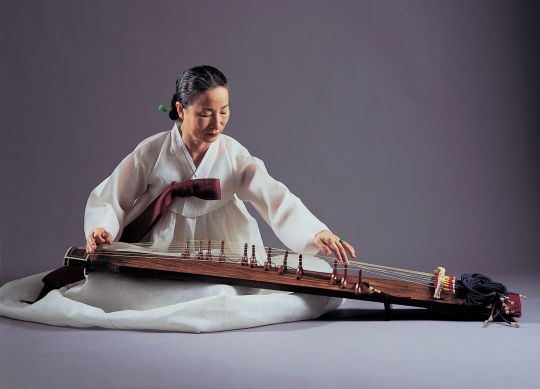
While modern-day Korean pop music has such an international cultural hold, I thought it would be interesting to study traditional Korean music. I wondered how similar Korean folk music is to American folk music. When I think of folk music, I have a very American view. To me, folk music is a person with a guitar singing slow songs about heartbreak or a whole band playing a fast beat with a banjo. My knowledge of folk music is very limited to the US. Through this blog, I want to expand my knowledge about traditional Korean music to better understand both international folk songs and Korea as a country.
Similar to American folk music, the Korean genre is also used to showcase complex emotions. However, the traditional music of Korea is divided into two different styles based on their intended audience. Traditional music for the elite uses a different sized gayageum than the songs played for the working class. An example of music for the ruling class is Jongmyo Jeryeak, the traditional music played during the ancestral rites of the Joseon kings. The songs historically played for the majority of the population are called pansori. This music usually contains a narrative story in its lyrics. Korean folk music is also characterized by its energetic rhythms and melodies. The United Nations Educational, Scientific and Cultural Organization (UNESCO) recently awarded pansori the title of a masterpiece of the Oral and Intangible Heritage of Humanity. The title pansori encompasses many different musical styles that also have historical roots in Korean village life. There is the sanjo style of pansori which means ‘scattered melodies’; it uses an hourglass-shaped drum. Additionally, the Sinawi musical style is based on rites performed by a female shaman. Pungmullori music involves both percussion and taepyeongso instruments. It focuses on tales of farming.
Here is a part of one of the most popular pansori songs called "Song of Chunhyang". The song yells the story about a girl named Chunhyang. The other people in her village were mean to her because she was not pretty. They executed her. After she dies, chaos takes over the village. One village magistrate thinks Chunhyang cursed the town. He writes about how great she is. He seems to have successfully appeased her and the curse is over. The lyrics of this song are what the magistrate wrote about Chunhyang.
Another aspect of traditional Korean music is its reliance on improvisation while using known melodies and themes. The first Korean musical score was written down by Hwang Byungki in 1962. He started recording music that had historically been passed down through oral tradition. Byungki is known to many as “the father of modern Korean music”. He studied both court music for the elite and folk music. Hwang really liked Sanjo music. He even started his own music school focusing on the style of sanjo. He led the path for Korean musicians to create a fusion of traditional Korean music and Western style of music composition. This movement of combining the ideas of traditional music in new formats is called Changjak-Gugak. Byungki revolutionized the way that Koreans thought about music and reintroduced the almost extinct gayageum to the public. Byungki‘s career highlights the strong connection between the traditional Korean music that he drew inspiration from and the modern Korean music movement that he is credited with starting.
As more mainstream American artists have embraced folk music aesthetics, so have some Korean pop stars. The group Topp Dogg, now called Xeno-T, incorporated many aspects of traditional Korea into their song “Arario” and its music video. The music video has women playing the gayageum. One of the most famous K-pop groups, BTS also highlighted folk elements in one of their songs. The song “Idol” contains a pansori rhythm with many folk instruments, including a brass gong called kkwaenggwari, a horn called gakgung, and a drum called janggu. Their choreography, specifically their jumping in the music video for the song, pulls inspiration from a folk dance called pungmul.
youtube
While American and Korean traditional music are very different, as they both use different types of instruments, both musical genres have certain characteristics in common. They are both known for being spontaneous. Folk musicians of both cultures historically do not play precomposed music. Furthermore, working class people play a big part in the folk genres of both countries. Their songs often touch on a traditional way of living, whether that be Korean village life or American rural life. Furthermore, many pop musicians today are influenced by this type of music. As a fan of American folk music, it was very exciting for me to learn and listen to Korean traditional music and how it is related to modern-day Korean music.


Citations
https://www.angelfire.com/alt/koreanmusic/folk.html https://asiatimes.com/2018/02/master-musician-father-modern-korean-music/
https://asiatimes.com/2018/02/master-musician-father-modern-korean-music/
4 notes
·
View notes
Text
Gion Matsuri: A Celebration for Health and Purification
By Ayumi Bonev
If you talk to a someone who attended Japanese school in the U.S. or Japan, almost all of them, including myself, will agree with the fact that they were forced to memorize the opening passage from Heike Monogatari, an epic about the battles between the Taira and Minamoto clans. The opening line reads “Gion shouja no kane no koe shogyou mujou no hibiki ari,” which translates to “the sound of the Gion [temple] bells echoes the impermanence of all things.” Although I have never visited Gion Temple, I have been learning about its historical and literary significance for over a decade thanks to my Japanese school teachers who made me memorize this passage every year. This shrine continues to be important to Japanese culture outside of past history and literature due to its ties to one of the biggest festivals in Japan: The Gion Festival (祇園祭).
The Gion Festival, or Gion matsuri, finds its origins about 1,200 years ago in 869 CE in Kyoto. Summers in Kyoto are extremely hot, humid, and prone to heavy rains. These created ideal conditions for cholera, dysentery, and malaria. Thus, in July of that year, plagues and floods swept through the city and killed hundreds of people. Emperor Seiwa believed that the flooding and epidemics were due to angry and vengeful spirits and ordered a goryō-e, or a purification ritual, and prayers to Susanoo-no-Mikoto, the Shintō god of the Gion Shrine, diseases, and healing. Supposedly, the ritual worked and, therefore, continued to happen every time there was an epidemic. By 970 CE, this ritual became an annual month-long festival in Kyoto held in July known as the Gion Matsuri.

One of the key aspects of the festival is the Yamaboko Junkō (山鉾巡行), the procession of floats, which occurs on July 17th and 24th. There are two main types of floats, the hoko and yama, which are built and lead by each neighborhood guild in Kyoto. The hoko floats are massive, weighing up to 12 tons and requiring 30-40 people to push or pull. The yama floats are slightly smaller, weighing 1,200-1,600 kg and requiring 14-24 people to push or pull. The floats are elaborately decorated with textiles from Kyoto and all over the world. Musicians sit in the floats and play traditional music, while others throw good luck charms to the crowds below. Check out this video to see how much time and effort goes into making these enormous floats:
youtube
After the first procession of floats on the 17th, Gion Shrine’s (now called Yakusa shrine) deities are carried around Kyoto in portable shrines called mikoshi to cleanse the neighborhoods. They will then say in temporary dwellings called otabisho until they are brought back to Yakusa shrine after the second procession of floats on the 24th.
Another important part of the festival is the three nights of celebration leading up to the float processions sequentially called yoiyoiyoiyama (宵々々山), yoiyoiyama (宵々山), and yoiyama (宵山). On these evenings, the streets close so people can visit the floats, buy good luck charms, and eat street food. My favorite street food is takoyaki, or fried ball-shaped dough with octopus inside which is then topped with various sauces and garnished with seaweed and dried bonito flakes! Some families who have lived in Kyoto for generations also open their traditional machiya style houses and display their heirlooms for the public to see.
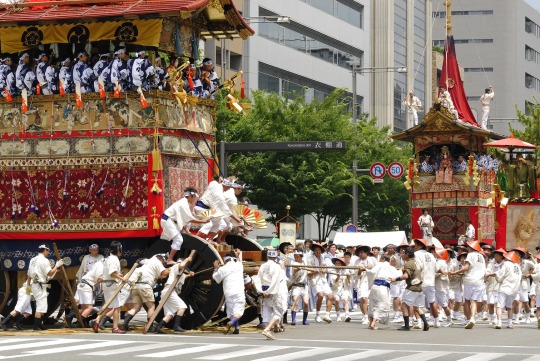
Because of the Meiji Restoration in 1868, Japan changed and erased many old customs while creating new traditions to try to better conform to Western standards. However, it makes me happy to see that the Gion Festival stood the test of time and remained continuous and unchanged for centuries. I hope that I can one day attend the Gion Festival to finally experience the celebration outside of the literature I grew up memorizing.
Sources
5 notes
·
View notes
Text
Christmas in Vietnam
by Christian Tanks

Vietnamese do in fact celebrate Christmas. Vietnamese children, in particular, feel the magic of Christmas. Missionaries from Portugal, Spain and France first introduced Christianity into Vietnam in the 16th century. It wasn't until the Trinh decided that Catholicism represented a threat to their power, and they outlawed Christianity in Vietnam. Even though there was a ban on Christianity, people would still continue to practice the faith. It was practiced secretly to avoid prosecution and sometimes execution.
The French empire used this time to invade vietnam and eventually colonize the Vietnamese. With the French's catholic influence, it promoted the practices and traditions of Christmas in Vietnam. This allowed the few vietnamese people who celebrated it to celebrate it without fear of prosecution.
youtube
Christmas is just a regular day to the vietnamese citizens who do not celebrate. People will still go to work, this is because Christmas in Vietnam isn't really considered a national holiday. Despite that, the people still enjoy the festivals and the celebrations that come with it. This is because the Vietnamese are considered loving and sociable people. The festivals and events are occasions for them to party and have a go time. Christmas in Vietnam is a grand party. It is a huge event, especially in Ho Chi Minh City, Vietnam. The celebrations here are just as those in the western hemisphere . The Christians in Vietnam attend a Midnight mass on Christmas Eve and return home to a sumptuous Christmas dinner. The Christmas dinner usually consists of chicken soup while wealthier people eat turkey and Christmas pudding.
People celebrate by throwing confetti, taking pictures and enjoying the Christmas decorations and lights of big hotels and department stores. These activities are also activities that you see in american traditions. These lights, pictures and gatherings are all apart of the festivities of Christmas. The Yuletide spirit of giving and sharing has been embraced by the Vietnamese. Generously, they give out gifts and presents during the Christmas celebrations in Vietnam. However, the children are more likely to have their stockings stuffed with goodies from Santa. The European customs of Santa Claus and the Christmas tree were popular and children would leave their shoes out on Christmas Eve.
youtube
https://vietnamdiscovery.com/culture-arts/christmas-in-vietnam/
0 notes
Text
I honestly enjoyed Full metal because it shows the power of brotherly love. No only that, they face adversity in every episode. I think it is cool that they are able to overcome these evils with their powers. I feel the creators made this brotherly love so intense because he wanted to convey that Japan citizens should love each other like brothers regardless of what adversities they are facing. Overall I think it was important todo this because this would typically boost the morale of Japanese citizens while at the same time being an influence to all anime watcher across the world. - Tank
Fullmetal Alchemist
Introduction
The popular anime series Fullmetal Alchemist was released on October 4, 2003, and it is widely considered to be a classic in the world of anime. The manga was written by Japanese artist Hiromu Arakawa on July 12, 2001. While the original series was a hit, the later version Fullmetal Alchemist: Brotherhood is far more popular.

Backstory
The show follows the adventures of the Elric brothers, Edward (Ed) and Alphonse (Al). The brothers have a deep passion for the art of alchemy which is essentially the ability to change one object into another. The one main rule of alchemy is the law of equivalent exchange: ‘To obtain something of equal value must be lost.’ For this reason, it is forbidden to use alchemy in order to create a human (Human Transmutation).

When the boys were young, they lost their mother in a house fire, and their father abandoned them leaving the boys all alone. Ed and Al dreamed of being state alchemist, so they already had a great knowledge in alchemy. One night they decided to bring their mother back through human transmutation; however, they were not ready for what was to come. During the transmutation, Ed lost his right arm, and Al lost his entire body. Luckily, Ed was able to attach Al’s soul to a set of armor during the chaos. Ed got a metal arm to replace his lost limb thus giving him the title Fullmetal Alchemist. It is Ed’s main purpose in life to get Al’s body back.
My Favorite Aspects
In the show, there is a big focus on the relationship between Ed and Al. It shows their struggles and their triumphs, and it reminded me a lot of my relationship with my own brother. Ed, being the older brother, would do anything for his young brother, and you can see through his determination to retrieve his Al’s body how much he struggles with Al’s perception of him. Even though Al will never admit it, Ed believes that Al resents him for what he did, and he can’t stand to live with himself. Their dense and complex relationship is one of my favorite parts of the series. In addition to their relationship, the orphaned boys are social outcasts, so they only really have each other. They are going out into the real world searching for the Philosopher’s Stone to help Al as children which adds to their misfit role. This gives the show a very interesting perspective.

I think the reason I really got into this show was because it didn’t fall into the typical anime narrative that many shows fall victim to. When Naruto released, I believe it was so popular that it created a template that future shows would use in order to be successful. For example, lots of anime have the main underdog character that wants to be the best of all time. They have a friendly rival that is always a little better than them until the end. They have to pass some test or exam to start their journey and always surprisingly pass. While Fullmetal Alchemist has similarities, it is has a very different style which is what caught my eye.
Will Guzman
2 notes
·
View notes
Text
I enjoyed reading this post because “Attack on Titan '' was really popular at my middle school. I remember that the boy I sat next to in homeroom would play this “Attack on Titan” video game every week. He would control a small character that would jump on and kill these giants. My memories of the game confirm Reggie’s statements about how gory and bloody the show must be. When learning about how anime and manga is made for such specific groups, it is interesting to look at stories like “Attack on Titan ''. Just because there are the categories of shonen and seinen, some forms of manga media might combine aspects of both to grow with their audience. It is really engaging to watch a show that matures with you. However, it can also be stressful for children, or even their parents, who think the show is for a specific age than watch it change before their eyes. Streaming really exuberances the problem. When “Attack on Titans” was originally airing, kids had to wait years for new seasons to come out. Now, a new generation can watch the show all at once at the same age.- Bonnie
Attack on Titan: Shonen or Seinen? (spoilers)

By: Reginald Matthews
Throughout this blog, I will refer to Attack on Titan as an anime and manga interchangeably because the anime is based on the manga. There are some differences, such as the time of release and small details in the plot (per the usual of manga and anime).
Anime serves as a great form of entertainment because every person could enjoy at least one series or movie based on their own preferences. The categories of anime are split based upon the preferences of age groups and gender (in the binary). In most cases, this makes it easier to distinguish between which anime would be appropriate for different ranges of age groups and genders. However, in the case of Attack on Titan, the classification of category is much more convoluted. The two categories in question are “shonen” and “seinen.” Shonen is represents anime and manga that has an audience of boys under eighteen while seinen represents anime and manga that as an audience of young adult men usually ranging from eighteen to the early twenties.

Evolution of Eren. Any age before ten is a flashback in the show.
According to MyAnimeList, Attack on Titan classifies as shonen, but anyone who has watched the show might argue against this for multiple reasons. However, the reason that Attack on Titan is shonen may have more to do with the starting age of the characters. The protagonist, Eren Jaeger, begins the show at age ten, but then goes through most of the show as a fifteen-year-old. However, by season four, he is nineteen years old. This is not uncommon for anime, as many have time skips resulting in the characters becoming older. Also, the interactions of the characters would be more relatable to that of a teen audience. For example, in one episode, Eren and another character, Jean, argue over getting girls, something a teen boy would most likely do.
youtube
Eren and Jean Fight/Argue
On the other hand, there is a lot of evidence to support that the show classifies as seinen rather than shonen. First, wholistically, the show has a plot line that gets harder to follow (at times) as it continues. This could mean that the author possibly intended that the story would also appeal to young men above eighteen. In addition, the violence and gore are graphic. In the first episode, a titan (a formerly human, giant monster) eats the protagonist’s mother. As the story continues, the violence only grows. This is especially true in season four where the primary fighting is between humans and other humans rather than humans and monsters.
*VIDEO TRIGGER WARNING* IF BLOOD OR VIOLENCE IS NOT YOUR THING, THEN DO NOT WATCH. This video is primarily to show how violent the show gets towards the end.
youtube
In conclusion, the show has elements that could make it both shonen and seinen. I would imagine the show classifies as shonen because it was produced by, Bessatsu Shōnen Magazine; this is a shonen magazine as stated in the name. My speculation is that the show gets more complicated as it goes because it wants to continue to keep the same audience engaged as it continues. The first volume of the manga was released in 2010, and the last volume was released in 2021. Therefore, if you began reading the manga at age thirteen, you would be twenty-four by the time you finished the entire manga. Consequently, I am sure the author took this into account and adjusted the plot and tone of the show accordingly. This is my theory as to why the show goes this way. The anime started in 2013 and finished in 2021, so this also applies to the anime.
References:
4 notes
·
View notes
Text
Chang'e and the Mid-Autumn Festival (中秋节)

Just a few weeks ago, Rhodes got together in the heart of campus to celebrate the Mid-Autumn Festival. Held on the 15th day of the 8th month in the lunar calendar, the festival is celebrated throughout Asia with different countries having different names.
Celebrated when the moon is at its fullest, the Mid-Autumn Festival highlights the tradition of moon worship. In traditional Chinese culture, the moon represented rejuvenation and life and such worship was often associated with women. The reason for the moon being such an important aspect of the Mid-Autumn Festival is because it marks the fall rice and fruit harvest in China. However, there is a more mystical origin too.

A long time ago, a highly skilled warrior named Hou Yi. After single-handedly stopping a disaster from devastating the world, an immortal saw his greatness and gifted him an elixir of immortality. While he considered it, he was also deeply in love with a woman by the name of Chang'e. Refusing to live on without her, Hou Yi gave her the elixir to hold. But, one of Hou Yi's apprentices learned of the elixir and attempted to forcefully take it from Chang'e for evil purposes. Knowing she could do nothing to stop him and Hou Yi being away, she drank the elixir to keep it out of the evil man's hands. Immediately, Chang'e flew into the sky. Desiring to stay with her husband, she chose the moon to inhabit. After Hou Yi learned of his wife's fate, he began to leave fruit and cakes that Chang'e loved out in his yard while also giving sacrifices for her sake. It is said that the people were so moved and sympathetic that they began participating in the veneration of Chang'e.
While the story stems from folklore and versions of it vary, the importance of the moon and its veneration persist in each telling. From this story and past tradition, the values of prayer, gathering, and appreciation are highlighted as fundamental aspects practiced during the festival.
It is believed that by praying and showing respect to the moon or Chang’e, the moon goddess, material and other wishes can be granted.
Gathering is the most important reason for the Mid-Autumn Festival. With the family unit, traditionally, being the most important aspect of one’s life and commitments, the festival brings about a chance for friends and family to reconnect and show appreciation for each other. In this way, the Daoist tradition of filial piety shines through the festival which only makes sense given how ingrained it is in traditional Chinese culture.

The most well-known tradition during the Mid-Autumn Festival is the consumption of mooncakes. Round in shape and only a few centimeters wide, the fillings of these cakes vary from red bean to lotus bean. The round shape symbolizes completeness and union and when sharing these cakes with friends and family, the practice represents unity within the family and the community at large.
With China being so large, there are a number of region specific traditions, food, and games that come with it. For example, in Guangdong province, it is said that young kids play a game called “Encircling the Toad” (guanxiamo). Children would run circles around a chosen “toad king” who would then pretend to turn into a toad after chanting a song. Another tradition is a gambling dice game called Bo Bing usually played in Xiamen.
Below is a short video showing what the festival looks like in places around China.
Each province or region has a unique way of celebrating the Mid-Autumn Festival. However, celebrating the moon, appreciating and connecting with family, and feasting are all shared aspects around China.
-安乐楷
link to sources here
7 notes
·
View notes
Text
Obon: A Celebration for Ancestral Spirits
By Ayumi Bonev
Every time I go back to Japan, one of the first things I do with my mother is visit my grandparents’ graves. We clean the graves, light incense, and leave offerings. Though many Japanese people—including my family—do not consider themselves religious, it is said that Japanese people are born Shinto and die Buddhist. Celebrations in life such as marriage and childbirth are done so through Shinto rituals, while events pertaining to death such as funerals are celebrated through Buddhist ones. This is apparent in the way Buddhist monks pray for my deceased ancestors or when I celebrate one of Japan’s biggest and most important festivals: Obon.
The Obon (お盆) festival is a three day celebration with Buddhist roots that pays respects to deceased ancestors. It is celebrated in July using the solar calendar in Eastern Japan and in August using the lunar calendar in Western Japan. My family is from Tokyo, so we tend to celebrate in July, but Obon is most commonly celebrated in August regardless of region.
The history behind why Obon is celebrated is based on a Buddhist myth. Mokuren (目犍) was one of Buddha’s ten great disciples and was known for his magical powers. One day, he used his powers to check on his deceased parents. He found that his father had achieved rebirth, but that his mother was suffering in the Realm of Hungry Ghosts. Buddha told Mokuren that his mother was filled with so much bad karma that he alone could not help her. He advised his disciple to make offerings to the Buddhist monks who were coming back from their monastic retreat and were thus replenished with good karma on the 15th day of the 7th month of the lunar calendar. Mokuren listened to Buddha, and when he made his offering, his mother was released from her suffering, and he danced with joy.
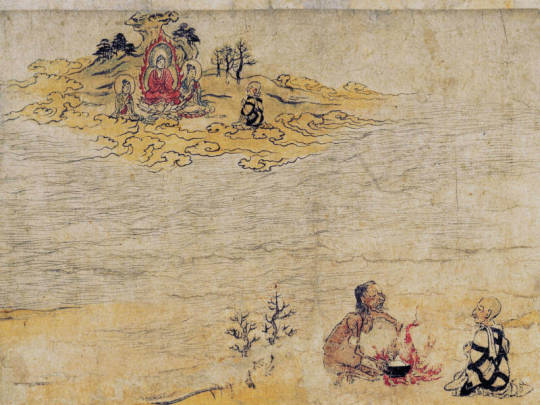
One of the key aspects of Obon is the bon dance, or bon odori. Mokuren’s joyful dance after freeing his mother is said to be the origins of the dance and even the festival itself. The bon odori is traditionally danced around a raised stage called a yagura accompanied by taiko drums. Many Japanese people, including myself, have grown up dancing to it. You can also try to learn how to dance to it here:
youtube
Lanterns are another import aspect of the festival. People take their chōchin lanterns (paper lanterns) to their family’s graves on the first day of Obon in a ritual called mukae-bon to welcome them back home. They then leave offerings such as incense, sweets, or flowers and clean the graves. On the last day of the festival, the ancestral spirits are guided back to their gravesites using the chōchin lanterns in a ritual called okuri-bon. In another ritual called the toro nagashi, lanterns which represent the spirits of ancestors are floated down rivers to celebrate them.
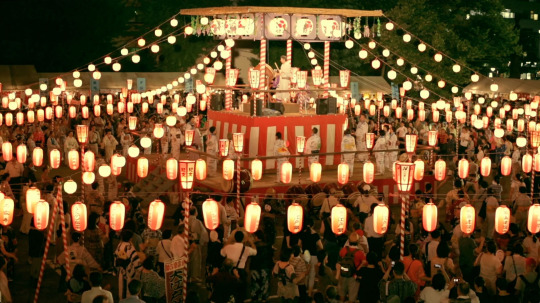
Interestingly, Obon is also a wonderful example of how different religions and philosophies coexist and intermingle with each other in Japan. Confucianism believes in the importance of family and filial piety. Shintoism believes that the human spirit remains forever as kami and protects their descendants. Such beliefs come together with a Buddhist legend to create the Obon festival.
Every time I go back to Japan and visit my grandparents’ graves, my mother cries. Every time I go back to Japan and celebrate Obon, my mother laughs and dances and reaches out to cousins she hasn’t talked to in years. Obon is not only a festival, but also a time for family to get together and celebrate the lives of deceased loved ones rather than mourn them.
Sources
6 notes
·
View notes
Text
Tet Trung Thu(Mid-Autumn moon festival)
By Christian Tanks

The Vietnamese do not celebrate Thanksgiving, instead they participate in a harvest festival called Tet Trung Thu. Tet Trung Thu is the Mid-Autumn moon festival which is held in the eighth lunar month and honors the Moon. It is the brightest at this time of the year. Next year it would land on September 29 . The festival which is intended for parents to dedicate more time to spend with their children. Due to the recent long harvest season, many parents didn't have much time to spend with their children.
youtube
During this time, parents take the time to make mooncakes, masks and lanterns with their children. This is something that the kids look forward too . Focussing on the quality time it takes to make these things with their kids, parents tend to take their time with this.
During the festival there is dancing , costumes and other festivities fit for the kids. The dances tend to be traditional dances, such as the dragon dance and the flower dance. Children bang on their drums and wear masks like a lion or tiger to frighten Ra Hu, the mythological creature responsible for the moon's phases and eclipses, to prevent him from gobbling up the full moon.
The celebration is believed to date back thousands of years to the beginning of settled agriculture in Southeast Asia. The festival's origin is often associated with the ascendancy of the moon over the sun in winter, the bounty of life, and prayers for the return of the sun's warmth and light. There are many folktale stories associated with this festival. One of the folktales are Trang Yi, The Lady in the Moon who took an immortality potion intended for her husband. She began to rise into the sky and became the Goddess of the Moon who appears in mid-Autumn to receive offerings. This video would explain to you as if grandma was telling you the story herself.
youtube
Even though Vietnam doesn't celebrate Thanksgiving, I feel like Tet Trung Thu shares some commonalities. Throughout the festival, families are thankful to have time to spend with their children and to give thanks to the moon goddess ,Trang Yi. By coming together as a community, the Vietnamese embraces the traditional dances and food. By doing this, they are giving thanks to those who came before them and created those traditions. They also embrace their culture gripping tight to what traditions they do have. Due to the fact of the westernization of Asia, many traditions were forgotten.
2 notes
·
View notes
Text
Chuseok
By Bonnie Kennedy

As the holiday season is approaching with Halloween at the end of the month, I started thinking about the different kinds of holidays around the world. This led me to learn about Chuseok, often labeled Korean Thanksgiving. This is one of Korea’s biggest holidays. The tradition offers an interesting look into Korean culture.
Chuseok reminds me how universally important it is for adults to go back to their hometowns and celebrate with their families. So many cultures have designated times of year set for people to visit their parents. Chuseok is one of those traditions. The movement of people during this time causes some of the worst yearly traffic in Korea. Every Thanksgiving growing up, my family would get stuck in awful traffic traveling from Chicago to Nashville. While being stuck in a car moving ten miles a year is not ideal, it is kind of comforting thinking of people across the Pacific Ocean in Korea facing the same challenge.
However, Chuseok’s length and placement in the calendar differentiate it from Thanksgiving. It is a four day long holiday that starts one day before Chuseok and ends two days after. Similar to how Christmas eve is a celebration within itself, the day before Chuseok is when the festivities begin. Chuseok is the 15th day of the 8th month of the lunar calendar. This usually falls into September and October. This year, it took place on September 10.
Like most holidays, there is a story behind Chuseok. It is believed to have began in Silla, one of the three ancient kingdoms in ancient Korea. This kingdom united Korea under the Unified Silla Dynasty. One of its kings started a month-long weaving contest. There was a great celebration for the team that weaved the most cloth. It is believed that the holiday is inspired by this event hundreds of years ago and harvest moon celebrations stemming from shamanism.
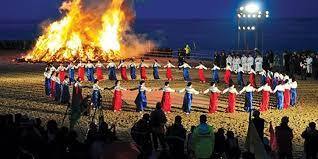

Like Thanksgiving, the holiday is about giving thanks and celebrating a good harvest. One of the traditional customs of Chuseok is Charye, a memorial rite where special food is made and offered to one’s ancestors. The food prepared is usually fresh rice, alcohol, and half-moon rice cakes. The different shapes of the folded and unfolded cakes represent the kingdom of Silla and its rival Baekje. Since Silla won, the half-moon shape is believed to lead to a happy future. Gifts are also a big part of Chuseok. They are given to friends, families, and coworkers. One traditional game played during the holiday is a Ssireum contest, a type of folk wrestling. Taekkyon, a type of traditional martial arts with rhythmic movement, is also performed. Villages also play Juldarigi, a big game of tug and war. A specific folk dance called Ganggangsullae is performed outside under the full moon. The youtuber sweetandtasty TV reports that not every Korean follows such traditions today. To some, Chuseok is a time to spend quality time with one’s family.

One aspect that marks Chuseok as unique is the focus on ancestors.To show respect, Koreans perform Seongmyo and Beolcho, where they visit and clean ancestor’s graves. While I have not visited my ancestors’ graves during Thanksgiving, I have seen some of them on my dad’s side. When I was around ten, I saw my grandmother’s parents’ graves. As a child, I was not very comfortable in a graveyard. However, I saw another relative’s grave this summer on a family trip abroad. This time, I appreciated the experience more. Thinking about the people who came before me was a really grounding force. It is a good way to remember all the sacrifices that people before you made. While graveyards can be a little daunting when they are not a place for celebration and respect in one’s culture, they offer a great reminder of the strength of familial bonds.
Learning about the Korean traditions of giving thanks by acknowledging one’s ancestors inspired me to follow their example. As I travel home this year for Thanksgiving, I will think about people all over the world who also visit home for celebrations of gratitude in their cultures.


Sources
youtube
2 notes
·
View notes
Text
I enjoyed this a-lot, Hunter x hunter used to be one of my favorite Animes. -Christian Tanks
Hunter x Hunter and Confucianism
Will Guzman
The anime series Hunter x Hunter was released on October 2, 2011 and has been one of the most watched shows of all time. The original manga was written by Japanese writer Yoshihiro Togashi in 1998. With a failed attempt to make the manga into a television in 1999, the Hunter x Hunter released in 2011 was a big hit, now on many popular streaming services such as Netflix, Hulu, and Crunchyroll. Like most anime, the show has a strong connection to Confucianism in East Asian cultures sharing traditional core values and social structures.

Hunter revolves around this 12-year-old boy, Gon, determined to be reunite with his father who he had not seen for many years. He lives in a small village far out in the country with no ideas on his father’s whereabouts. His father is a Hunter, and Gon believes the only way to find his father is to become a Hunter himself. This is where the first major connection to East Asia can be seen in the show.
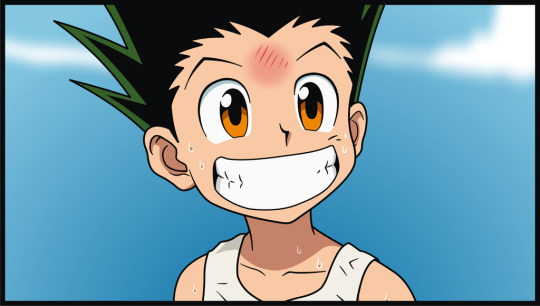
Confucianism was one of the earliest religions in this region and has had major influences on modern the East Asian lifestyle and culture. One of the biggest aspects in the Confucian philosophy was the importance of social hierarchy. Social status was essentially the determining factor when it came to respect and social value. Each class had its role and was expected to follow it. In Hunter, there is a similar form of thinking when it comes to social class. Obviously, there are the wealthy, commoners, and poor; however, there is another class, Hunters.

The Hunter Association consists of the world’s smartest and most skilled trackers and fighters. They main objective, however, is to protect society from potential threats which makes Hunters the most respected members of the society. In order to receive a Hunter’s license, one must pass the Hunter Exam which only a handful of hundreds pass every year. While it is the hardest test in the world, everyone has the opportunity to take this exam. This exam reminded me of the Civil Service Exam in China during the High Tang Era. Even though one is risking their life when the decide to take the Hunter Exam, both tests are similar in the sense that they give everyone an opportunity to move up in society. The Civil Service Exam was designed to find the best candidates for important roles in government. This allowed for even the lowest classes to move up in society.

Another aspect of Confucianism seen in Hunter are the core values of righteousness and hard work. Being a hunter comes with a lot of power and responsibility, and sometimes a hunter will act in their own best interest rather than for the good of all turning away from the true purpose of being a hunter. It is very easy to fall into darkness; however, when Gon is put to the test, he always does the right thing.
youtube
3 notes
·
View notes
Text
Tanabata Matsuri: A Celebration for the Star-Crossed Lovers
By Ayumi Bonev
Until I graduated high school, every other summer was spent visiting my grandmother in Tokyo, Japan. My favorite part about the visits were always the festivals. I loved dressing up in a yukata, playing festival games, and eating street food until I thought I was going to throw up. Out of the many festivals I have gone to, my favorite one is, without a doubt, the Tanabata Matsuri (七夕祭), or the Star Festival.
In my opinion, the reason behind why Tanabata Matsuri is celebrated has one of the most heartwarming yet bittersweet pieces of folklore attached to it. Once upon a time, there was a princess called Orihime (織姫) who weaved beautiful clothing by the heavenly river, Amanogawa (天の川) or the Milky Way. However, she spent so much time weaving that she became sad that she could not find love. So, her father, the God of the Heavens (天帝), found her a lover, a cow herder named Hikoboshi(彦星)who lived across the heavenly river. Princess Orihime and Hikoboshi fell so madly in love that they began to neglect their duties; Orihime stopped weaving cloth for her father, and Hikoboshi’s cows began to wander the heavens. Thus, the God of the Heavens became angry and separated the lovers with the heavenly river. Orihime begged her father to let them be together, and he eventually agreed to let them meet one day a year: the 7th day of the 7th month. The Tanabata Matsuri is held on July 7th every year to celebrate the reunion of the literal star-crossed lovers.
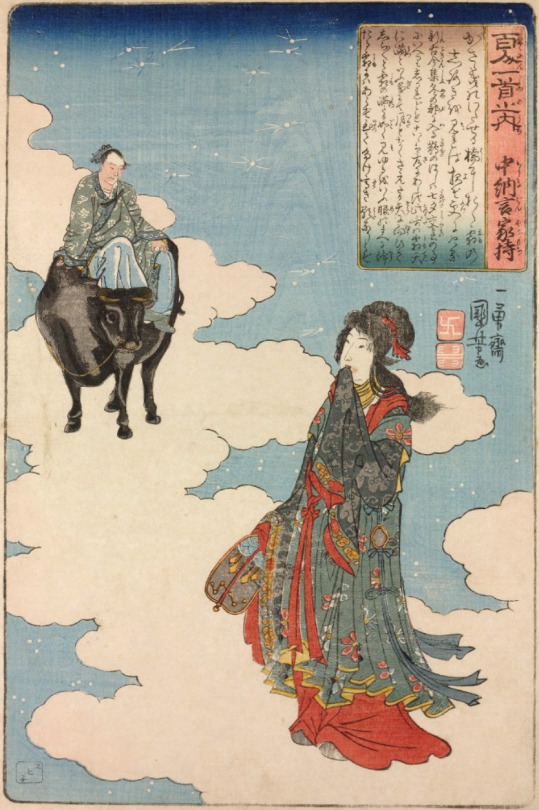
To celebrate the love between Orihime and Hikoboshi, Japanese people write their wishes on colorful pieces of paper called tanzaku and hang them on bamboo. The taller and straighter the bamboo, the more likely your wish will reach the heavens! Although I wouldn’t consider myself a superstitious person, I still write the same wish on my tanzaku every year—health and longevity for my friends and family—because I am slightly scared of what will happen if I stop. Traditionally, the bamboo would then be floated down the river the next day to ensure the wishes will be granted by the heavens. Expressing your hopes and dreams to the heavens can be done in other ways as well. Other traditional decorations to convey such messages include folding paper cranes (orizuru) for longevity or hanging Japanese money bags (kinchaku) for prosperity. When walking through a Tanabata festival, you will see hundreds of these traditional decorations and massive paper streamers lining the streets and weighing down the branches of bamboo.

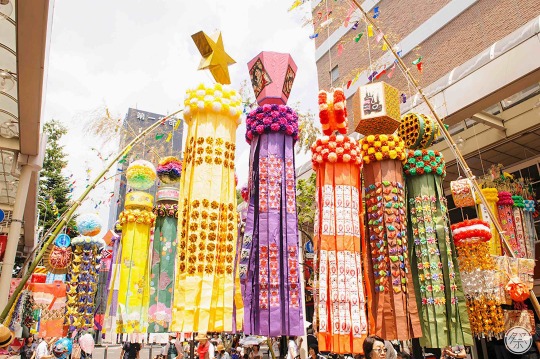
Another Tanabata “must-do” is, of course, to sing the folk song Tanabata-Sama! Most Japanese people, including myself, have sung this song since childhood. You can listen to it here:
youtube
Even though my grandmother has since passed and I visit Japan less and less, the bittersweet reunion of the star-crossed lovers on Tanabata is when I similarly reconnect with the memories of my childhood summers with my grandmother in Tokyo. I still write my tanzaku on July 7th, stick them on the little magnetic whiteboard in my room, and text my mom “happy Tanabata!” without fail. Tanabata serves as a reminder for many Japanese people—and everyone else who celebrates—around the world to reach out to or reconnect with the people they hold close to their heart.
P.S. If you ever look up at the night sky, try to find Princess Orihime and Hikoboshi, otherwise known as the stars Vega and Altair!
Sources
11 notes
·
View notes
Text
Folk Entertainment in Korea
By Bonnie Kennedy
Folk traditions offer such an engaging insight into specific cultures. While it is also interesting to study a place's mainstream pop culture, like the kind of music, television, and books that people consume, there is something about cultural traditions that have prevailed for thousands of years that are especially fascinating. Moreover, the significance of folk traditions is often ignored or undervalued. As I want to learn more about Korea, I thought it would be useful to look at what types of entertainment are prevalent in Korean folk culture. Growing up, I attended many art and music festivals so I thought that would be a good topic of study. As someone who loves festivals, I wondered what kind of events and rituals take place during traditional Korean festivals.

One popular art performance during festivals is called Nongak. The act is a communal rite. Today, it is tied to the national identity of Koreans. Nongak involves percussion and wind instruments combined with dancing, dramatic acts, and acrobatic acts. Audiences watch skits and listen to regional folk music. Performers wear colorful clothes. For instance, the percussion musicians usually wear white clothes, a colored sash, and red, black, or blue jacket. Historically, nongak was filled with ritualist aspects that decreased over time as the entertainment piece increased in importance. Over time, the percussion musicians became professional musicians known as samulnori. Nongak changed with Korea. After the Japanese occupation, a single national nongak competition helped Koreans express themselves. While there are certain characteristics common in nongak, there are regional differences in the way that different Korean communities practice the tradition. In Gyeonggi-do and Chungcheong-do, more children perform than in other provinces. Hence, not only does this practice connect Koreans together, it also further bonds smaller communities together. In some performances, different flags are used to represent small regions. As Americans acknowledge regional differences and pride in the United States, I loved learning about how this performance is used to express that same sentiment of regional unity and identity across Korea. In my home town, many festivals are named after the neighborhood they take place in. For instance, I regularly attend the Logan Square Arts festival which pulls most of its visitors from the surrounding community. Hence, I enjoyed reading about how people in Korea also use festivals and entertainment to bring neighborhoods together.

Moreover, I also learned about the different types of nongak. The performance can be presented for different purposes whether that be to appease gods, drive away evil spirits, pray for or to celebrate a good harvest. One such nongak is geollip nongak which is done to raise money. Another type of nongak is the pangut performance which is an organized dance made for the local people of the community and presented outside in nature. Pangut can be performed as a competition. One of the hallmarks of pangut is the intensive planning involved. The performance starts with all the participants greeting the audience after they arrive. There is an initial street performance called gilgut or jilgut. Then the percussionists start to play and dancing begins. Folk songs are then sung before individuals perform different acts such as gong playing. Next, there are skits or acrobatics. The performers leave the stage dancing and singing.
youtube
While watching a few videos of nongak, all the entertainers in their colorful clothes provided an interesting visual as they danced and jumped. I found the white ribbons that the performers used in the video above particularly relaxing. I forgot how beautiful the art of ribbon waving is. They performed ribbon dancing in a way I had never seen before; they danced with the ribbons attached to their heads. It was amazing. I was astonished at the control they held over their head movements. I enjoyed how rhythmic the show was. The percussion instruments provided a nice steady beat initially that became heavier and louder over time. Throughout the performance, the changes in tempo and intensity of sound kept me engaged. I never expected what was coming next from plate spinning to audience participation; it was exciting to watch. Moreover, the fact that each community had its own version of this tradition made it very easy to watch many videos of this tradition.
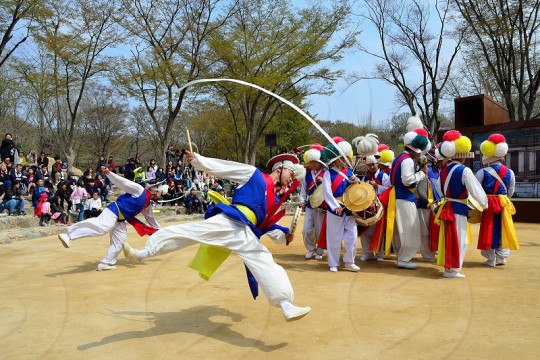
Clearly, this impressive practice has had a very important place in Korea’s history and a continued sense of identification. I would love to witness such an amazing performance in person one day. Initially, I had no idea that Korea had such a strong history and tradition of communal entertainment. It is fascinating to see the history of folk entertainment as the performances changed with the country. The wide range of categories for nongak emphasizes its great significance in Korea. This practice has a long past and modern day presence of strengthening communities.
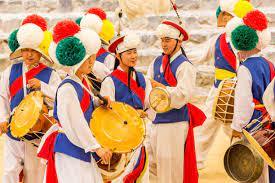
Sources
https://ich.unesco.org/en/RL/nongak-community-band-music-dance-and-rituals-in-the-republic-of-korea-00717 https://www.korea.net/NewsFocus/Culture/view?articleId=123313
2 notes
·
View notes
Text
Perfume Pagoda Festival
by Christian Tanks
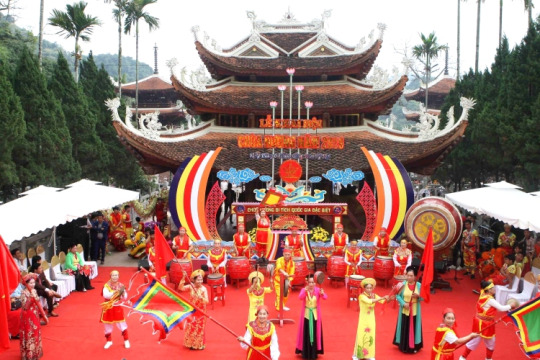
A Vietnam Festival
The Perfume Pagoda Festival is the longest lasting festival in vietnam. It starts soon as the Tet Festival is over. Also known as the Chua Huong, it is one of the most significant pilgrimage festivals in Vietnam. Every year thousands of people make the pilgrimage to the country's well known buddhist sites. Unlike the many other festivals in Vietnam, the Huong Pagoda Festival in Hanoi does not revolve around traditional games, but rather on the spiritual trips to the caves, pagodas and temples. The participation in the ceremonies are soon to be more favorable towards Buddha.
youtube
The main temple in the mountains is known as the Perfume Pagoda. It is also called Chua Trong which means Inner Temple, it lives inside the Huong Tich Cave One of the most important activities in this festival is to pray in the Huong Tich Cave. According to the legend, a pilgrimage to Huong Pagoda in the spring will bring good health, prosperity, and happiness . The many Visitors attending Huong pagoda festival tend to make wishes and when they are worshiping Buddha in the pagoda, they pray for their wishes to come true. They also bring offerings with them from home, including boiled chicken, boiled pigs’ heads and steamed sticky rice. After they finish their prayers, each visitor will take a small portion of the offering (called loc) which is then carried home for their family. Loc is a sacred and precious thing as it is believed to bring good luck to those who eat it.
youtube
Many people make this pilgrimage for different reason, not all make the trip for religious reasons. Other often take the trip because the time of the festival is when nature looks the best, Th trees have bloomed during this time, so many visitors take the journey strongly off their love for nature. By the end, most visitors are looking to be blessed by Buddha. Being blessed by Buddha means to be prosperous, healthy and good fortune.

Resources
https://sacredsites.com/asia/vietnam/perfume_pagoda_chua_huong.html
7 notes
·
View notes
Text
China and The Chongyang Festival (重阳节)
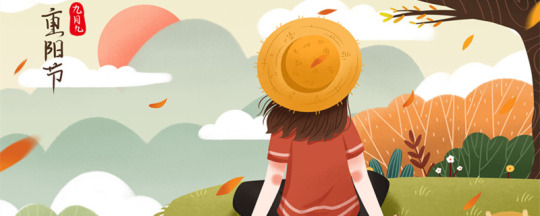
Long ago during the Han Dynasty, a man named Huan Jing and his family were experiencing great troubles. Not only were his parents ill but an evil spirit tormented his town. One day, a Taoist immortal being came to Huan Jing and warned him that he should take his family to the highest part of the village to avoid the coming atrocities. Heeding the spirits' suggestion, Huan Jing did just that. On the ninth day of the ninth lunar month, he took his family up a mountain and, upon returning, found his village in chaos and ruins. Remembering the advice the being gave him, he used chrysanthemum wine to defeat the demon and save his town.
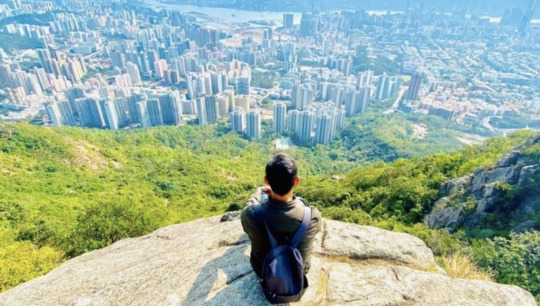
While the method of slaying the demon differs from wine to a magical sword depending on the source, the story itself is what matters. This is the folk tale the Chongyang Festival originated from. Celebrated throughout China and Hong Kong the Chongyang Festival, or Double Nine Festival, highlights the importance of ancestral veneration, cleansing of negative energy, and continuation of Taoist tradition. The date itself, 9/9 of the lunar calendar, is picked because in Taoist belief, the number 9 is associated with Yang; masculine energy, light, and the heavens. It being 9/9 means there is an imbalance of energy that must be corrected through certain means.
The festival is significant because it represents a continuation of Taoist traditions even in a modern, arguably westernized society. While China sees rapid economic and urban growth, the people still hold onto practices like honoring ancestors and celebrating festivals rooted in Taoist principle. While Taoism can be considered an ancient philosophical and religious tradition, its principles have survived the test of time in China through being malleable to modern society.

While traditions vary between mainland China and Hong Kong, some are practiced throughout. To restore balanced energy, many Chinese flock to their ancestors' gravesites. Cemeteries become very crowded while families begin showing respect by cleaning family graves, remarking inscriptions, and leaving food offerings. Additionally, like Huan Jing, climbing mountains to pray to one's ancestors, for good fortune, and balance is a common practice during Chongyang. For food, many enjoy chrysanthemum wine or tea (as seen below) and chongyang cakes (as see above). Not only was Chrysanthemum, a flower native to East Asia, used to slay the demon in Huan Jing's story, but it has also been historically claimed to promote longevity and thus used in the celebration. Another tradition is to fly kites high into the air as it represents your bad energy floating off into the sky.
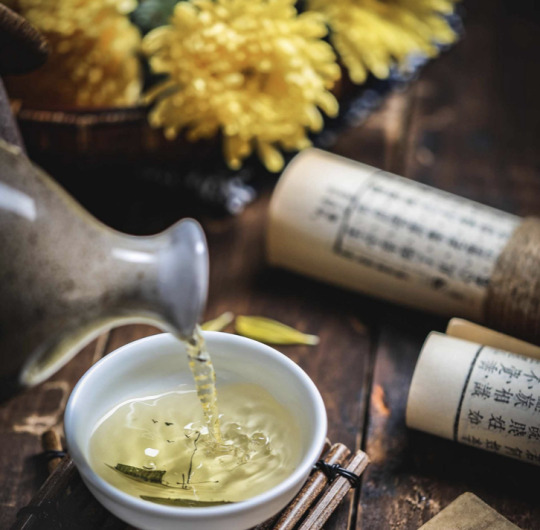
Specifically for China, Chongyang is marked as National Senior's Day. People are encouraged to reach out to older family members to show thankfulness and veneration, relating back to the Taoist tradition of filial piety.
In summary, the Chongyang Festival is celebrated throughout East Asia and represents the deep appreciation for traditional practices and principles that find their roots in Taoism even in a modern society.
-安乐楷
Source List can be found here!
5 notes
·
View notes